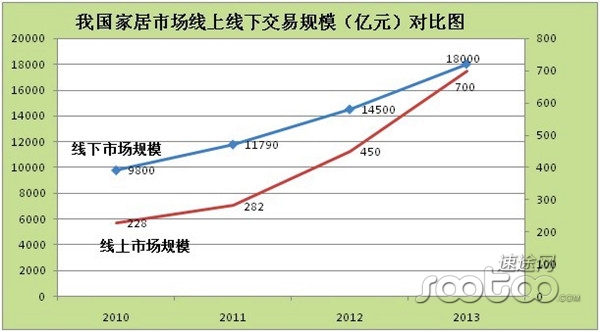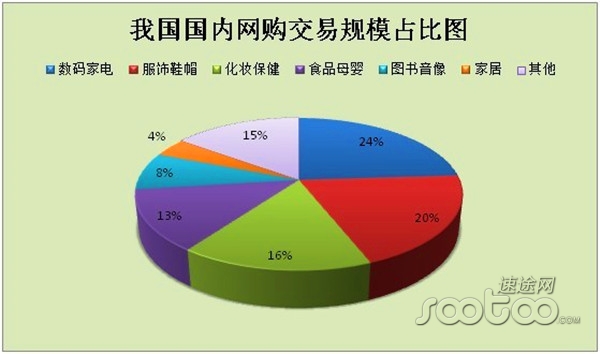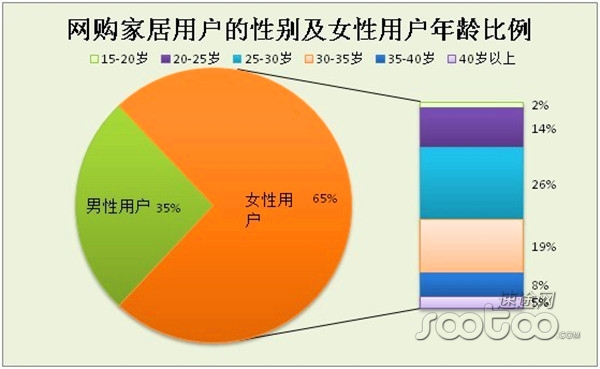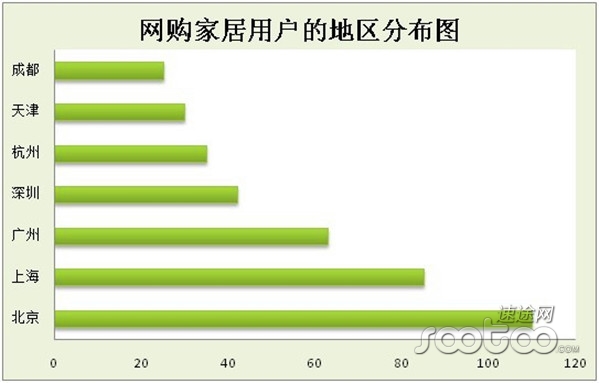As an indispensable part of the traditional industry, the home industry has always played a role in promoting China's economic development. Traditional home furnishing enterprises are also facing the operational difficulties brought about by the increase in personnel and rental costs. Expanding their own categories and sales channels to increase sales has also become the mainstream trend in the current home furnishing industry. With the development of e-commerce, e-commerce in the home industry has been put on the development agenda by more and more enterprises. As the largest e-commerce online trading platform in China, Tmall is constantly exploring the road of electric shock. However, from the recent developments, Tmall's home dreams have gone extremely hard, and many home stores have combined to resist. So, what is the market structure of China's home e-commerce?
The analyst team of the Speedway Research Institute combined with the network-related data to analyze the domestic e-commerce market in China, and explained the scale, development and proportion of the household e-commerce market for netizens.
In 2013, the size of the home market was 1.80 billion, and the online market was only 70 billion yuan.

(Speedway Research Cartography)
The Speedway Research Institute has compiled the sales scale data of the home furnishing industry for nearly 4 years. As a whole, the traditional home furnishing industry has always occupied the bulk of the home furnishing market. In 2010, the sales volume was 980 billion yuan. In 2011, the scale reached 117.90 billion yuan. In 2012, the scale of trading was 145 billion yuan, and it is expected to reach 1.8 trillion yuan in 2013. The home industry's trillion-dollar market has grown significantly, occupying the mainstream of home sales. From the growth rate of the home market, we can see that China's demand for home is growing stronger.
On the other hand, online shopping online shopping scale, although the growth is obvious, but compared with the offline home market is very rare. In 2010, the domestic e-commerce market transaction scale was 22.8 billion, accounting for 2.3% of the offline market; in 2011, the online home transaction volume was 28.2 billion, accounting for 2.4% of the offline market; in 2012, the online home market transaction volume was 45 billion yuan, accounting for the offline market. 3.1%; online scale is expected to be 70 billion yuan in 2013, compared with the offline home market accounted for only 3.9%.
From the perspective of the online market as a whole, the growth trend is obvious. The main reason is that offline home furnishing companies and online shopping platforms such as Tmall are actively promoting the journey of home electric shock. The main reason for the small size is the joint resistance of offline home stores. And the experience of the purchase link is not enough. From a long-term perspective, the status of home e-commerce is becoming more and more important and its transaction scale will be larger and larger. China's current home furnishing industry has a relatively low proportion, so what is the proportion of online shopping in other countries?
China's household online shopping proportion is relatively low, only 3.9%

(Speedway Research Cartography)
The Speedway Research Institute has compiled the proportion of online shopping in other countries. Overall, the proportion of home online shopping in China is relatively low, which is also the opportunity for China's home e-commerce market. The highest proportion of home online shopping is Japan, accounting for 20.5%; followed by the United States accounting for 19.8%; the United Kingdom accounting for 16.2%; France accounting for 12.8%; and China's home online shopping ratio is only 3.9%, and ranking The first Japan was nearly five times worse.
The main demand for homes in Europe and the United States is comfort and convenience. The demand for home is more personalized and more diverse. It is also normal to update the home. The domestic home market is going to buy a home in the event of a new home renovation. Due to its special attributes, it is difficult for large-scale sales promotion on the Internet in China. How to solve the logistics distribution, payment and shopping experience are the problems that China's home e-commerce has to solve. The online shopping environment, logistics level and shopping process in developed countries are better than those in China, and their reputation index is better than ours. The benign development of its network environment has also cleared many obstacles for the e-commerce road of the home industry. The development of e-commerce in China is relatively short, and many policies and services have not kept up. The most traditional things like home e-commerce have many challenges when it comes to e-commerce.
In the scale of online shopping transactions, home online shopping transactions account for only 4%

(Speedway Research Cartography)
The traditional home furnishing industry includes building materials and furniture. Its offline trading is second only to digital home appliances and apparel shoes and hats. It is the third largest category. The transaction scale this year will also be close to 2 trillion yuan. However, from the scale of online transactions organized by the Speedway Research Institute, the scale of home transactions is relatively low, accounting for only 4%. Digital home appliances are still the first in online shopping, accounting for 24%; followed by clothing and shoes, accounting for 20%; cosmetic care accounting for 16%; food mother and baby accounting for 13%; books and audio-visual ratio It is 8%.
The scale of online and offline categories in China is roughly the same, but the scale of home transactions on the Internet has been relatively low. The overall transaction size of domestic household e-commerce accounts for a relatively low proportion. How to make e-commerce at home makes it more convenient for users to purchase products will be a problem that China's home industry and major e-commerce platforms need to consider.
Home online shopping is dominated by women, accounting for 65%

(Speedway Research Cartography)
At present, the main force of home online shopping in China is still dominated by female users, accounting for 65%, and males only account for 35%. The overall proportion of China's online shopping market is still dominated by female users, and female users like to compare the price of products and product information online. For China's home market, women's aesthetics for homes tend to be more sensitive than men's, and women's users are the mainstay for house decoration and other issues. Among female users, female users aged 25-30 accounted for 26%. This part of the population is in the stage of marriage and imminent marriage. For most people in China, the premise of marriage is mainly the house, and the decoration of the house is often based on female opinions. Followed by female users aged 30-35, accounting for 19%. The proportion of online shopping for 20-25 years old women has reached 14%. This part of the population is the main group of online shopping. It is more sensitive to price, and more online shopping will be selected at the time of purchase. Female users between the ages of 15 and 20 have almost no habit of shopping online, accounting for only 2%. The proportion of female users who buy online at 35-40 years old is 8%, and the proportion of online shopping for female users over 40 years old is only 5%.
Online shopping home users are mainly distributed in economically developed areas

(Speedway Research Cartography)
From the distribution of users of online shopping homes, the proportion of online shopping in the more developed areas is higher. The top ranked is Beijing, followed by Shanghai, Guangzhou, Shenzhen, Hangzhou, Tianjin and Chengdu. The awareness of online shopping in developed cities is relatively high, and people are more likely to receive the Internet than other regions. At the same time, the distribution of developed cities is also relatively good, the offline home market is also prosperous, users can go offline and experience online payment. Online has a price advantage over offline, which is very attractive to most people.
The traditional home store network influence index ranked Red Star Meikailong ranked first

(Speedway Research Cartography)
Note: The network influence is calculated by the number of network searches, weights, media evaluation, and user evaluation.
The team of the Express Research Institute has compiled network-related information from major traditional enterprises and obtained influence rankings according to the corresponding data processing. From the data analysis point of view, Red Star Macalline has the highest influence, ranking first, and the influence index is 83. The main reason is that Red Star Macalline has the ability to integrate the powerful home market resources under the line, and the spread of the online e-commerce team. Integration advantages. Actually, the home has not yet launched its e-commerce sector (online on November 11). Its network influence is mainly from the offline, and its TV advertising and other resources endorsed by Chen Baoguo also add a lot to its exposure and network influence. Actually, the network influence ranks second, with an impact index of 80. It is expected that the e-commerce team will have a good performance after going online. Traditional home stores such as Qumei, IKEA, Quanyou, Haobai, Haomeijia, Yuexing Home, etc. are ranked 3 to 8.
Overall, the traditional home store network influence index is not much different, the highest index gap is only 18, but the overall network influence of home enterprises is not high. The main reason is that although domestic home stores have taken action on the Internet, they do not have much practical actions and measures. At the same time, because home goods have their special product attributes, there are still many obstacles in online shopping, and to a certain extent. This has caused the general influence of all home stores in the Internet field to be generally low.
From the current development of the domestic market, household e-commerce has obvious growth rate but small scale. At the same time, the proportion of users is relatively scattered, and the regions are mainly developed cities. How to optimize the shopping process and shopping experience, how to ensure after-sales service and logistics links are the problems that home business e-commerce must face. At the same time, how to avoid conflicts with offline businesses when traditional home furnishing companies conduct e-commerce is also a choice for these companies to go without e-commerce.
Medical Case,Custom Aluminum Case,Aluminum Box,Bank Travel Carrying Case
Changzhou Junye Aluminum Case Co., Ltd , https://www.junye-box.com
